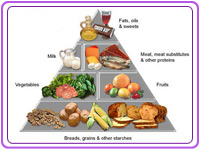 Not the pyramids in Egypt, we mean the food pyramid. A food pyramid basically tells you what to eat most and what to scrimp on. At the base of the pyramid are things that you should consume the most like cereals and pulses. As the pyramid tapers off to its peak, it tells you about the things you should eat sparingly like oils and fats. In the middle of the pyramid are food items to be consumed moderately like fruits and veggies followed by milk and meat products. Keep this in mind when you eat or plan your meals.
Not the pyramids in Egypt, we mean the food pyramid. A food pyramid basically tells you what to eat most and what to scrimp on. At the base of the pyramid are things that you should consume the most like cereals and pulses. As the pyramid tapers off to its peak, it tells you about the things you should eat sparingly like oils and fats. In the middle of the pyramid are food items to be consumed moderately like fruits and veggies followed by milk and meat products. Keep this in mind when you eat or plan your meals.
Never underestimate the power of monitoring your health. A major part of staying well is consistency in health a nd that can only be figured out if the indicators of your health are regularly monitored. These indicators are Sugar Levels, Blood Pressure, Haemoglobin Count, Urine Analysis, Cholesterol and Lipid Profile, Liver Function Test, ECG, and Chest X-Ray. Many hospitals such as Apollo Hospitals have comprehensive health check-ups that cover all these tests and more. These tests become all the more important as you age.
nd that can only be figured out if the indicators of your health are regularly monitored. These indicators are Sugar Levels, Blood Pressure, Haemoglobin Count, Urine Analysis, Cholesterol and Lipid Profile, Liver Function Test, ECG, and Chest X-Ray. Many hospitals such as Apollo Hospitals have comprehensive health check-ups that cover all these tests and more. These tests become all the more important as you age.
There is no alternative to exercising and you don’t just need to do it when you gain a few extra pounds. Exercise keeps you active and energetic and it is great for the joints. However, be careful of over-straining yourself. Consult a physician or fitness trainer to figure out a fitness plan that is best suited for you. And do remember to wear the right outfit and footwear while exercising, else you may injure yourself. Keep
moving and don’t allow yourself to be glued to a chair all day.
Water Rules!
Keep your body well-hydrated by drinking a lot of water throughout the day. Water is actually a miracle drink that aids many of your bodily functions like getting rid of toxins, eliminating wastes, regulating body temperature, lubrication of body joints, assisting in digestion processes, and much more. This is one drink you should indulge in all day and every day!
Relax:
Stress leads to many physical and mental disorders. Keep it at bay with deep breathing, leisurely strolls, meditation, chanting, and listening to
 music. Other ways to relax include socializing, traveling, talking to friends, or basically doing anything that pleases you and makes you feel good.
music. Other ways to relax include socializing, traveling, talking to friends, or basically doing anything that pleases you and makes you feel good.







